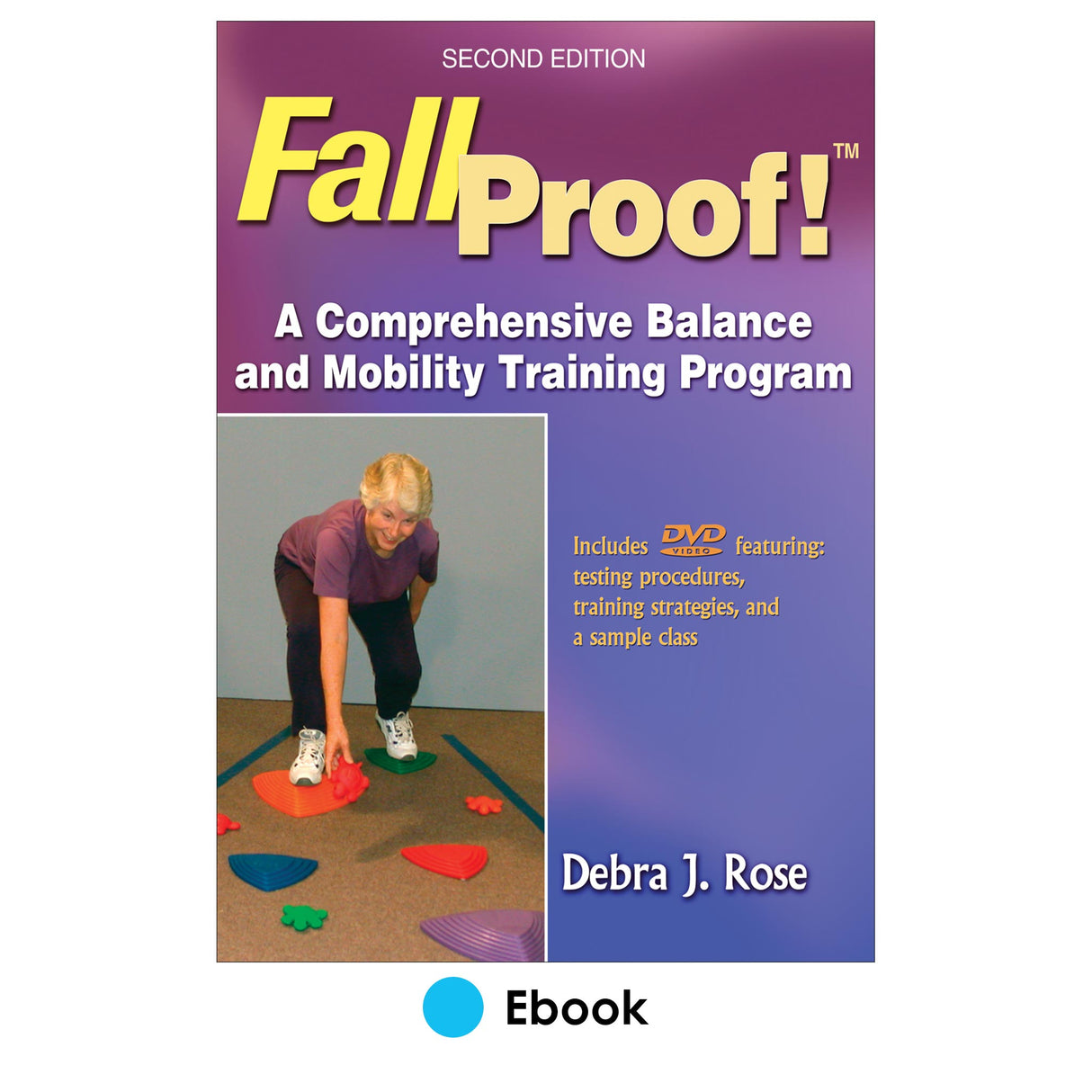Fallproof! 2nd Edition PDF With Web Resource
A Comprehensive Balance and Mobility Training Program
Author: Debra J. Rose
$63.00 USD
Access Duration: 10 Years
The second edition of FallProof! A Comprehensive Balance and Mobility Training Program is a practical guide to implementing a multidimensional balance and mobility training program to address the increasing incidence of falls among older adults. Now available with companion online video, this edition is a research-based resource with a range of balance and mobility assessments and detailed instructions on implementing the FallProof! program.
The second edition contains everything that made the original edition so popular and the FallProof! program so widely recognized and well received. Written by Dr. Debra Rose, foremost expert in balance disorders and programming, this book continues to be the only text to address the multiple dimensions that contribute to balance and mobility. By exploring the reasons underlying falls, readers gain the knowledge to offer more comprehensive assessment and programming. This research-based approach has been field tested and has shown considerable success in a range of instructional settings, including community-based and residential care environments.
The FallProof! program is customizable for individual clients, with exercise progressions for early, middle, and late class modules. In addition, the program offers the following benefits:
• Flexibility. Program participants can engage in group activities that take into account their individual abilities so that the program is not too easy or too difficult for them.
• Guidance. Safe and easy ways of presenting each of the program’s exercise components are illustrated, addressing issues ranging from safety concerns to the best ways to provide feedback to participants.
• Supplemental materials. Downloadable and reproducible health, assessment, and program-related questionnaires help instructors gather crucial information for effective programming.
• Results. The FallProof! program has been proven to reduce the risk of falling in participants who’ve completed one or more rotations of the program.
The second edition of FallProof! contains significant content updates and new references and features for both professionals and students. A new section on goal setting and behavioral management techniques is included, as well as a section on prioritizing screening and assessment tests, scheduling subsequent tests, and organizing testing in a group environment. Each chapter has tools for maximizing retention and understanding—including a summary statement, a quiz, and a “practical problems” section. An extensive research bibliography and a subject index make it easy for readers to access the information and explore subjects in greater depth.
A web resource with video clips makes the information in the text applicable to real situations. It shows how to administer screening and assessment tests, demonstrates selected exercise progressions for the major program modules, and provides a sample FallProof! class session in action. Reproducible forms and checklists help instructors with program implementation and can be easily downloaded from the web resource.
This comprehensive manual is used in the only authorized FallProof! certification program offered by the Center for Successful Aging at California State University at Fullerton and is a must for anyone in the field developing balance and mobility programs for at-risk older adults. It delivers the theory along with the specialized knowledge and practical skills required for creating programs that ensure older adults maintain the high level of balance and mobility essential in avoiding falls and aging successfully.
Part I. The Theory Behind the Program
Chapter 1. Understanding Balance and Mobility
What Is Balance?
Terminology
Postural Control Strategies for Controlling Balance
Multiple Systems Contribute to Balance and Mobility
Age-Associated Changes in the Systems Contributing to Balance and Mobility
Case Studies
Summary
Test Your Understanding
Practical Problems
Chapter 2. Why Do Many Older Adults Fall?
Multiple Factors Cause Falls
Effects of Common Medical Conditions
Effect of Medications on Balance and Mobility
Fear of Falling
Are the Risks the Same for All Older Adults?
Practical Implications for Program Planning
Summary
Test Your Understanding
Practical Problems
Part II. The FallProof Program for Improving Balance and Mobility
Chapter 3. Screening and Assessment
Health and Physical Activity Patterns
Assessing Functional Ability
Assessing Fall Risk
Assessing the Multiple Dimensions of Balance and Mobility
Summary
Test Your Understanding
Practical Problems
Chapter 4. Center-of-Gravity Control Training
Seated Balance Activities
Standing Balance Activities
Floor-to-Standing Transfers
Summary
Test Your Understanding
Practical Problems
Chapter 5. Multisensory Training
Forcing the Use of the Somatosensory System to Control Balance
Forcing the Use of the Visual System to Control Balance
Forcing the Use of the Vestibular System to Control Balance
Exercises Coordinating Eye and Head Movements
Summary
Test Your Understanding
Practical Problems
Chapter 6. Postural Strategy Training
Practice Requirements
Progressive Exercise Activities
Summary
Test Your Understanding
Practical Problems
Chapter 7. Gait Pattern Enhancement and Variation Training
Overview of the Gait Cycle
Mechanisms Controlling Gait
Age-Associated Changes in Gait
Effect of Pathology on the Gait Pattern
Gait Pattern Enhancement and Variation Training
Culminating Activities
Summary
Test Your Understanding
Practical Problems
Chapter 8. Strength and Endurance Training
Selected Upper-Body Strength Exercises
Selected Lower-Body Strength Exercises
Selected Exercises for the Foot and Toes
Summary
Test Your Understanding
Practical Problems
Chapter 9. Flexibility Training
Selected Neck and Upper-Body Flexibility Exercises
Selected Lower-Body Flexibility Exercises
Summary
Test Your Understanding
Practical Problems
Part III. Implementing the FallProof Program
Chapter 10. Setting the Stage for Learning
Understanding the Stages of Learning
Understanding Different Learning Styles
Introducing the Skill Being Learned
Identifying and Correcting Errors in Performance
Summary
Test Your Understanding
Practical Problems
Chapter 11. Program Planning and Class Management Techniques
Following the Initial Assessment
Setting Individual Program Goals
Before Each Class Session
During Each Class Session
Between Class Sessions
After Each Follow-Up Assessment
Communicating With Class Participants
Summary
Test Your Understanding
Practical Problems





